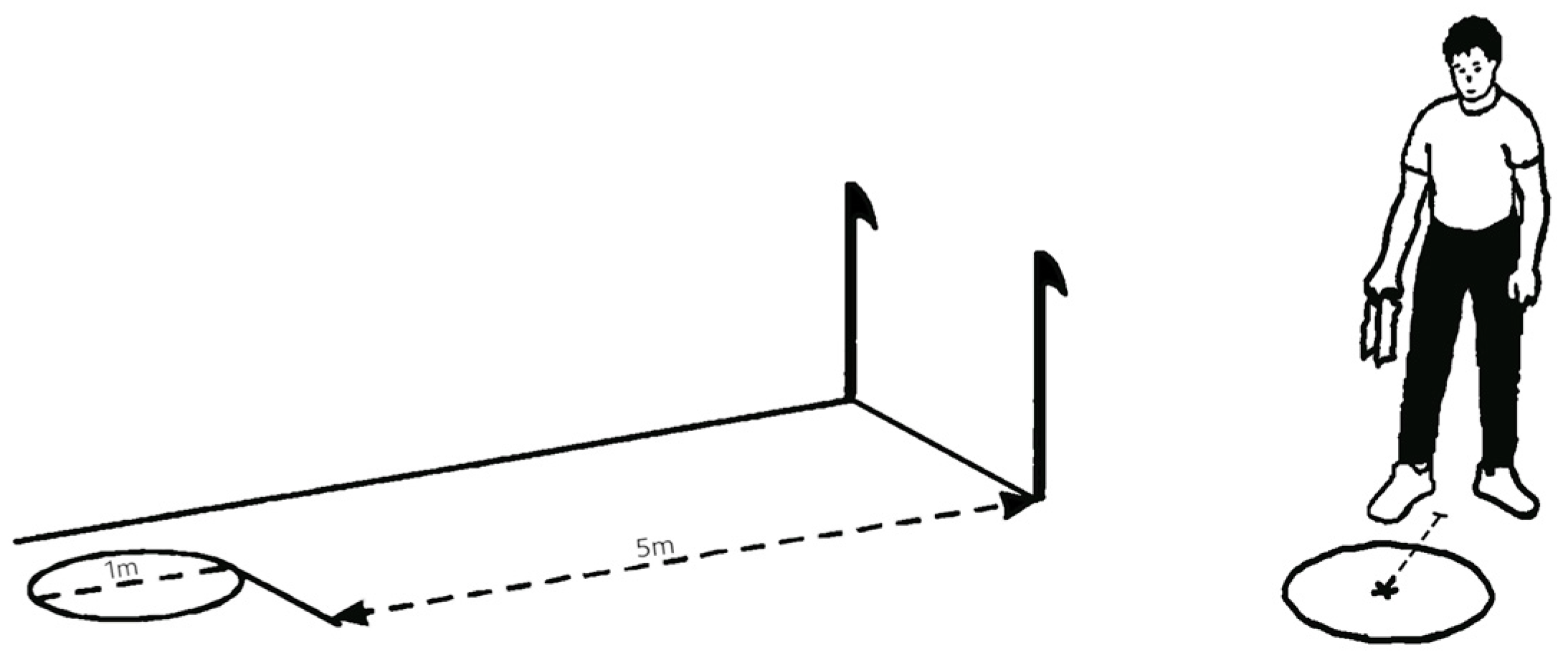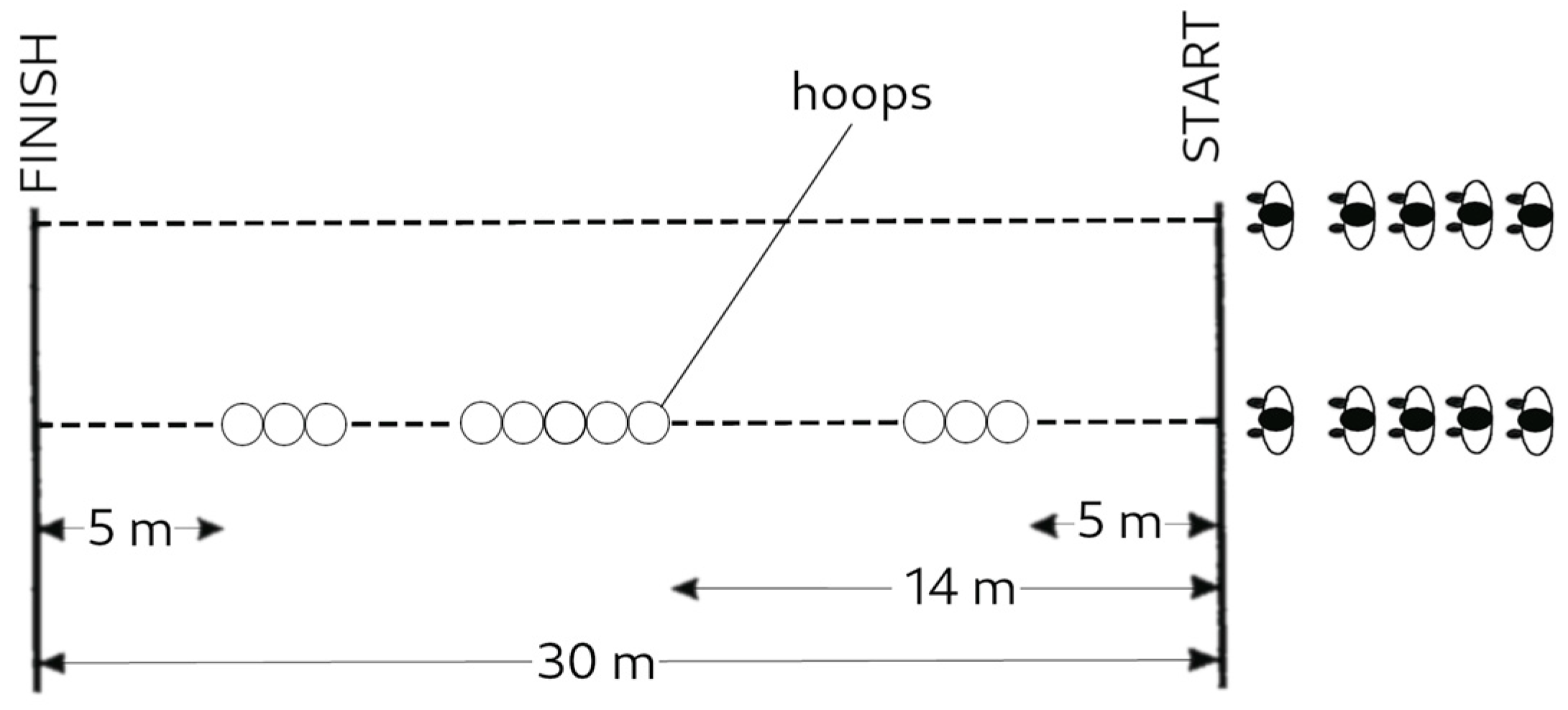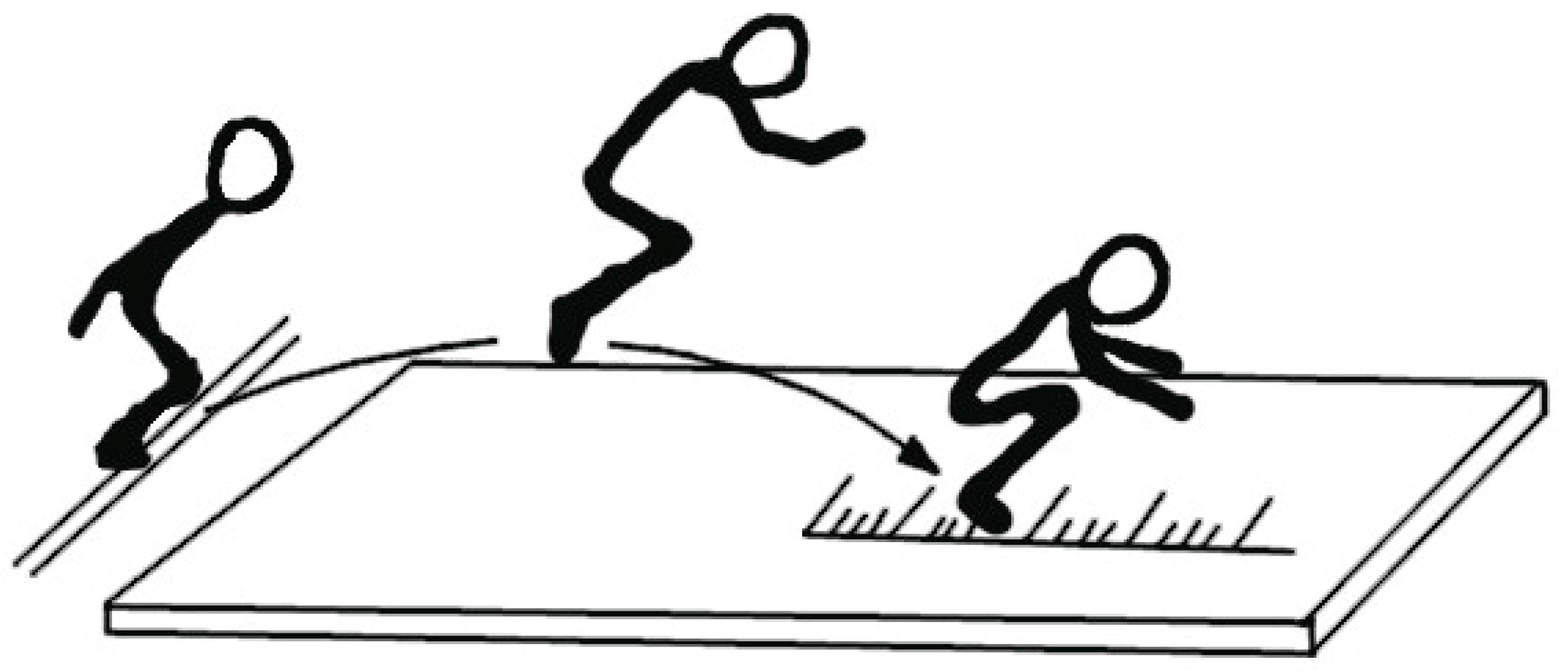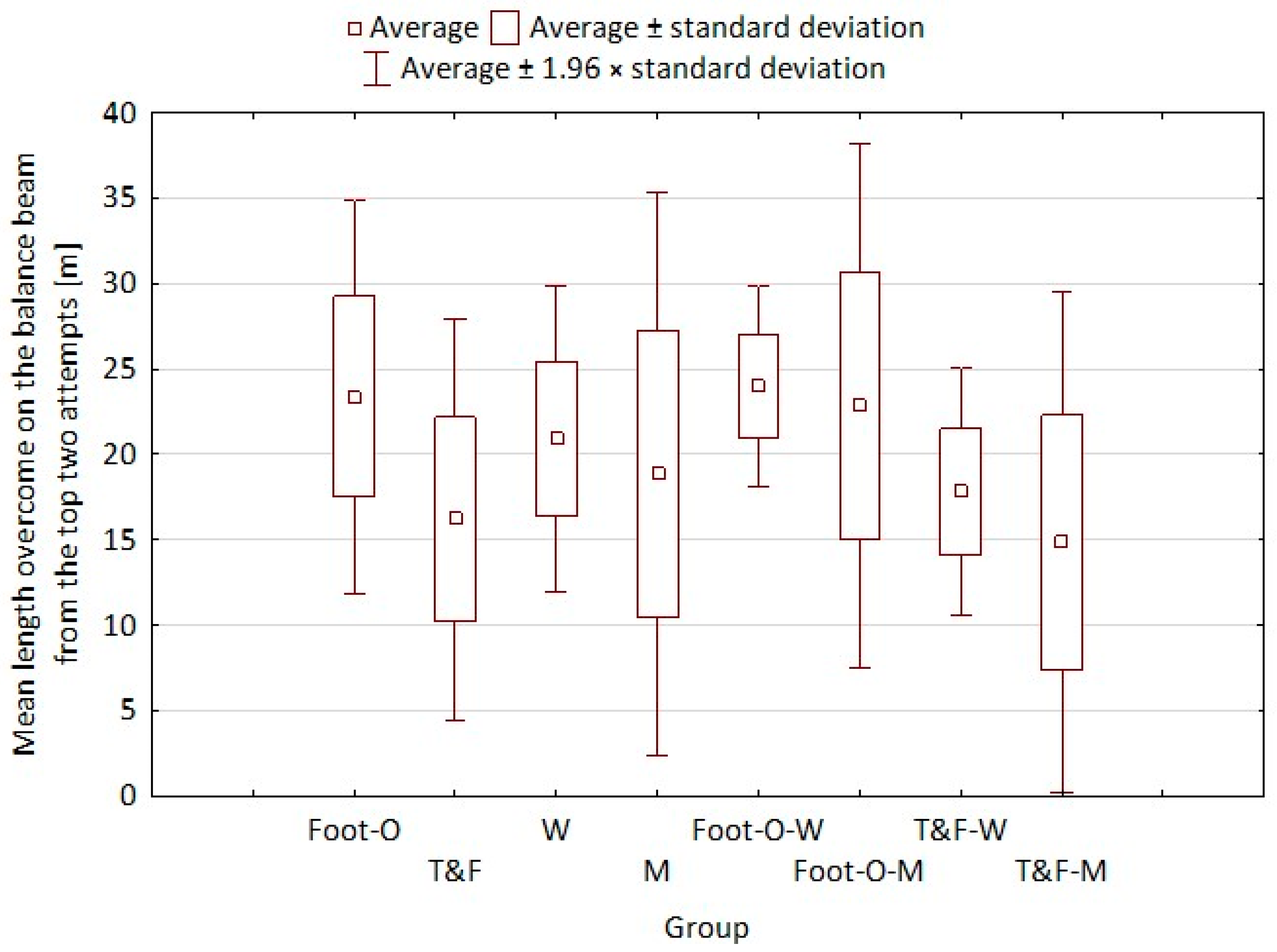Differences in Coordination Motor Abilities between Orienteers and Athletics Runners
Abstract
1. Introduction
2. Materials and Methods
2.1. Participants
2.2. Measures
- “Walk to the goal”;
- “Run at a given pace”;
- “Walk on the balance beam”;
- “Standing long jump from a place at 50% of maximum effort”.
2.3. Procedures
2.3.1. “Walk to the Goal” Test
2.3.2. “Run at a Given Pace” Test
2.3.3. “Walk on the Balance Beam” Test
2.3.4. “Standing Long Jump from a Place at 50% of Maximum Effort” Test
2.4. Statistical Analysis
3. Results
3.1. Assessment of Spatial Orientation (T1)
3.2. Assessment of Rhythmisation (T2)
3.3. Assessment of Balance (T3)
3.4. Assessment of Kinaesthetic Differentiation (T4)
4. Discussion
5. Conclusions
Practical Applications and Future Research
Author Contributions
Funding
Institutional Review Board Statement
Informed Consent Statement
Data Availability Statement
Acknowledgments
Conflicts of Interest
References
- Van Damme, T.; Simons, J.; Sabbe, B.; van West, D. Motor abilities of children and adolescents with a psychiatric condition: A systematic literature review. World J. Psychiatry 2015, 5, 315–329. [Google Scholar] [CrossRef] [PubMed]
- Burton, A.W.; Miller, D.E. Movement Skill Assessment; Human Kinetics: Champaign, IL, USA, 1998. [Google Scholar]
- Kelso, J.A. Coordination Dynamics. In Encyclopedia of Complexity and System Science; Meyers, R.A., Ed.; Springer: Berlin, Germany, 2009; pp. 1537–1564. [Google Scholar]
- Cazzola, D.; Gaspare, P.; Preatoni, E. Can coordination variability identify performance factors and skill level in competitive sport? The case of race walking. J. Sport Health Sci. 2016, 5, 35–43. [Google Scholar] [CrossRef] [PubMed]
- Schmidt, R.; Lee, T. Motor Control and Learning: A Behavioral Emphasis, 5th ed.; Human Kinetics: Champaign, IL, USA, 2011. [Google Scholar]
- Mullineaux, D.; Uhl, T.L. Coordination-variability and kinematics of misses versus swishes of basketball free throws. J. Sports Sci. 2010, 28, 1017–1024. [Google Scholar] [CrossRef]
- Stergiou, N.; Jensen, J.L.; Bates, B.T.; Scholten, S.D.; Tzezis, G. A dynamical systems investigation of lower extremity coordination during running over obstacles. Clin. Biomech. 2001, 16, 213–221. [Google Scholar] [CrossRef] [PubMed]
- Besson, T.; Macchi, R.; Rossi, J.; Morio, C.Y.M.; Kunimasa, Y.; Nicol, C.; Vercruyssen, F.; Millet, G.Y. Sex Differences in Endurance Running. Sport Med. 2022, 52, 1235–1257. [Google Scholar] [CrossRef] [PubMed]
- Mottet, M.; Eccles, D.W.; Saury, J. Navigation in outdoor environments as an embodied, social, cultural, and situated experience: An empirical study of orienteering. Spat. Cogn. Comput. 2016, 16, 220–243. [Google Scholar] [CrossRef]
- Creagh, U.; Reilly, T. Physiological and biomechanical aspects of orienteering. Sport Med. 1997, 24, 409–418. [Google Scholar] [CrossRef]
- Giljanović, M.; Jurić, V. Orijentacijski sport i orijentacijske karte. Ekscentar 2014, 17, 108–113. [Google Scholar]
- Jouanin, J.; Mason, P.; Kahn, J. Évolution des erreurs techniques et de quelques variables physiologiques pendant la course d’orientation. Sci. Sports 1995, 10, 195–199. [Google Scholar] [CrossRef]
- Moser, T.; Gjerset, A.; Johansen, E.; Vadder, L. Aerobic and anaerobic demands in orienteering. Sci. J. Orienteer. 1995, 11, 3–30. [Google Scholar]
- Gjerset, A.; Johansen, E.; Moser, T. Aerobic and anaerobic demands in short distance orienteering. Sci. J. Orienteer. 1997, 13, 4–25. [Google Scholar]
- Pesce, C.; Cereatti, L.; Casella, R.; Baldari, C.; Capranica, L. Preservation of visual attention in older expert orienteers at rest and under physical effort. J. Sport Exerc. Psychol. 2007, 29, 78–99. [Google Scholar] [CrossRef] [PubMed]
- Vukadinović, N.; Juhas, I.K.J. Orienteering section as a form of extracurricular activities. Phys. Cult. 2015, 69, 59–69. [Google Scholar]
- Seiler, R. Cognitive processes in orienteering—A review. Sci. J. Orienteer. 1996, 12, 50–66. [Google Scholar]
- Zagorodnikova, D.M.; Guseva, N.L. Sport orienteering practices and their impact on cognitive mental processes in students. Theory Pract. Phys. Cult. 2020, 11, 24–26. [Google Scholar]
- Chaloupska, P. Analysis of erring in selected orienteering runners. J. Hum. Sport Exerc. 2015, 10, 4–6. [Google Scholar] [CrossRef]
- Batista, M.M.; Paludo, A.C.; Gula, J.N.; Pauli, P.H.; Tartaruga, M.P. Physiological and cognitive demands of orienteering: A systematic review. Sport Sci. Health 2020, 16, 591–600. [Google Scholar] [CrossRef]
- Dias, A.; Dantas, E. A tomada de decisão na orientação. Rev. Edu. Física 2004, 128, 12–17. [Google Scholar]
- Bird, S.; Balmer, J.; Olds, T.; Davison, R.C. Differences between the sexes and age-related changes in orienteering speed. J. Sports Sci. 2001, 19, 243–252. [Google Scholar] [CrossRef]
- Cherepov, E.; Epishev, V.; Bykov, E.; Stoliarova, N.; Stovba, I. Assessment of the stability of body functional systems in orienteers. J. Phys. Educ. Sport 2019, 19, 1686–1689. [Google Scholar] [CrossRef]
- Huikko, P.; Raus, S. Online Orienteering Guide for Teachers 2020; Haaga-Helia University of Applied Sciences: Helsinki, Finland, 2020. [Google Scholar]
- Raczek, J.; Mynarski, W.; Ljach, W. Kształtowanie i diagnozowanie koordynacyjnych zdolności motorycznych. In Podręcznik Dla Nauczycieli, Trenerów i Studentów AWF (Shaping and Diagnosing Coordinating Motor Abilities. A Manual for Teachers, Trainers and Students of the University of Physical Education); AWF Katowice: Katowice, Poland, 2002. (In Polish) [Google Scholar]
- Thomson, J.A. Is continuous visual monitoring necessary in visually guided locomotion? J. Exp. Psychol. Hum. Percept. Perform. 1983, 9, 427–443. [Google Scholar] [CrossRef] [PubMed]
- Paquet, N.; Rainville, C.; Lajoie, Y.; Tremblay, F. Reproducibility of distance and direction errors associated with forward, backward, and sideway walking in the context of blind navigation. Perception 2007, 36, 525–536. [Google Scholar] [CrossRef] [PubMed]
- McGuiness, D.; Sparks, J. Cognitive style and cognitive maps: Sex differences in representations of a familiar terrain. J. Ment. Imag. 1983, 7, 91–100. [Google Scholar]
- Pollatou, E.; Gerodimos, V.; Zissi, V.; Zervanou, D.; Karadimou, K. Spatial orientation ability in boys and girls toddlers. Sci. J. Orienteer. 2009, 17, 39–45. [Google Scholar]
- Souman, J.L.; Frissen, I.; Sreenivasa, M.N.; Ernst, M.O. Walking Straight into Circles. Curr. Biol. 2009, 19, 1538–1542. [Google Scholar] [CrossRef]
- Coluccia, E.; Louse, G. Gender differences in spatial orientation: A review. J. Environ. Psychol. 2004, 24, 329–340. [Google Scholar] [CrossRef]
- Loomis, J.M.; Da Silva, J.A.; Fujita, N.; Fukusima, S.S. Visual space perception and visually directed action. J. Exp. Psychol. Hum. Percept. Perform. 1992, 18, 906–921. [Google Scholar] [CrossRef] [PubMed]
- Ellard, C.G.; Shaughnessy, S.C. A comparison of visual and nonvisual sensory inputs to walked distance in a blind-walking task. Perception 2003, 32, 567–578. [Google Scholar] [CrossRef] [PubMed]
- Rieser, J.J.; Ashmead, D.H.; Talor, C.R.; Youngquist, G.A. Visual perception and the guidance of locomotion without vision to previously seen targets. Perception 1990, 19, 675–689. [Google Scholar] [CrossRef]
- Machowska, W.; Cych, P.; Siemieński, A.; Migasiewicz, J. Effect of orienteering experience on walking and running in the absence of vision and hearing. PeerJ 2019, 7, e7736. [Google Scholar] [CrossRef]
- Pośpiech, D.; Juras, B.; Raczek, J. Sprawność motoryczna uczniów w wieku 10–17 lat z wybranych regionów japonii i polski (Motor skills of students aged 10-17 from selected regions of Japan and Poland). Antropomotoryka 2008, 41, 17–27. (In Polish) [Google Scholar]
- Jensen, K.; Johansen, L.; Kärkkäinen, O.P. Economy in track runners and orienteers during path and terrain running. J. Sport. Sci. 1999, 17, 945–950. [Google Scholar] [CrossRef] [PubMed]
- Hébert-Losier, K.; Mourot, L.; Holmberg, H.C. Elite and amateur orienteers’ running biomechanics on three surfaces at three speeds. Med. Sci. Exerc. 2015, 47, 381–389. [Google Scholar] [CrossRef] [PubMed]
- Türkmen, Ö.; Biçer, B. Effects of 8-Week Orienteering Training on Physical Fitness Parameters among Adolescents Aged 14–18 Years. BioMed Res. Int. 2022, 2022, 5068599. [Google Scholar] [CrossRef] [PubMed]
- Galan, Y.; Dotsyuk, L.; Vaskan, I.; Kushnir, I.; Hauriak, O.; Lohush, L.; Kuchumova, N.; Beshlei, O. Monitoring the effectiveness of innovative forms of orienteering during the Covid-19 pandemic. J. Phys. Edu. Sport 2022, 22, 1885–1892. [Google Scholar] [CrossRef]
- Vincent, H.K.; Brownstein, M.; Vincent, K.R. Injury Prevention, Safe Training Techniques, Rehabilitation, and Return to Sport in Trail Runners. Arthrosc. Sports Med. Rehabil. 2022, 4, e151–e162. [Google Scholar] [CrossRef]
- Nilsson, J. Adaptation in eye gaze duration and coordination with speed in human walking and running. LASE J. Sport Sci. 2020, 11, 36–46. [Google Scholar] [CrossRef]
- Bressel, E.; Yonker, J.C.; Kras, J.; Health, E.M. Comparison of static and dynamic balance in female collegiate soccer, basketball, and gymnastics athletes. J. Athl. Train. 2007, 42, 42–46. [Google Scholar]
- Hurt, S.D. Pre-existing Anxiety and Vestibular Symptoms: The Relationship to Coordination, Balance, and Reaction Time in College Athletes. Ph.D. Thesis, Institute of Technology, Melbourne, FL, USA, 2021. [Google Scholar]
- Schmidt, M.; Egger, F.; Kieliger, M.; Rubeli, B.; Schuler, J. Gymnasts and Orienteers Display Better Mental Rotation Performance Than Nonathletes. J. Ind. Differ. 2016, 37, 1–7. [Google Scholar] [CrossRef]
- Hafer, J.F.; Peacock, J.; Zernicke, R.F.; Agresta, C.E. Segment coordination variability differs by years of running experience. Med. Sci. Sports Exerc. 2019, 51, 1438–1443. [Google Scholar] [CrossRef]
- Hinrichs, R.N. Whole Body Movement: Coordination of Arms and Legs in Walking and Running. In Multiple Muscle Systems; Springer: Berlin, Germany, 1990; pp. 694–705. [Google Scholar]
- Minetti, A.E.; Moia, C.; Roi, G.S.; Susta, D.; Ferretti, G. Energy cost of walking and running at extreme uphill and downhill slopes. J. Appl. Physiol. 2002, 93, 1039–1046. [Google Scholar] [CrossRef] [PubMed]
- Padulo, J.; Annino, G.; Migliaccio, G.M.; D’Ottavio, S.; Tihanyi, J. Kinematics of Running at Different Slopes and Speeds. J. Strength Cond. Res. 2012, 26, 1331–1339. [Google Scholar] [CrossRef] [PubMed]
- Millet, G.Y.; Divert, C.; Banizette, M.; Morin, J.B. Changes in running pattern due to fatigue and cognitive load in orienteering. J. Sports Sci. 2010, 28, 153–160. [Google Scholar] [CrossRef] [PubMed]
- Kujala, U.M.; Nylund, T.; Taimela, S. Acute injuries in orienteerers. Int. J. Sports Med. 1995, 16, 122–125. [Google Scholar] [CrossRef] [PubMed]
- Von Rosen, T.; Halvarsson, B. Preventing lower extremity injury in elite orienteerers: Study protocol for a randomised controlled trial. BMJ Open Sport Exerc. Med. 2018, 4, e000347. [Google Scholar] [CrossRef]





| Tests | ||||||||||||||||
|---|---|---|---|---|---|---|---|---|---|---|---|---|---|---|---|---|
| T1 | T2 | T3 | T4 | |||||||||||||
| Differences between groups | Mean (SD) (cm) | U | Z | p | Mean (SD) (s) | U | Z | p | Mean (SD) (m) | U | Z | p | Mean (SD) (%) | U | Z | p |
| Foot-O | 33.87 (±13.28) | 34.50 | −1.67 | 0.094 † | 1.32 (±0.30) | 54.00 | 0.39 | 0.694 † | 23.36 (±5.87) | 20.50 | 2.59 | 0.009 ** | 84.43 (±9.18) | 38.00 | −1.45 | 0.149 † |
| T&F | 45.27 (±13.92) | 1.30 (±0.27) | 16.18 (±5.98) | 89.48 (±7.59) | ||||||||||||
| Sex differences | Mean (SD) (cm) | U | Z | p | Mean (SD) (s) | U | Z | p | Mean (SD) (m) | U | Z | p | Mean (SD) (%) | U | Z | p |
| Women | 39.32 (±10.40) | 55.50 | 0.26 | 0.792 † | 1.38 (±0.26) | 50.00 | 0.63 | 0.531 † | 20.90 (±4.56) | 46.50 0.86 | 0.389 † | 88.38 (±6.17) | 57.00 | 0.17 | 0.869 † | |
| Men | 39.78 (±17.69) | 1.26 (±0.30) | 18.83 (±8.40) | 85.77 (±10.36) | ||||||||||||
| Differences between Sports | Mean (SD) (Rank) | U | Z | p |
|---|---|---|---|---|
| Foot-O | 4.27 (±2.87) | 21.50 | −2.53 | 0.011 * |
| T&F | 7.82 (±2.76) | |||
| Differences between Sexes | Mean (SD) (Rank) | U | Z | p |
| Women | 5.50 (±2.98) | 51.00 | −0.56 | 0.574 † |
| Men | 6.50 (±3.59) |
Disclaimer/Publisher’s Note: The statements, opinions and data contained in all publications are solely those of the individual author(s) and contributor(s) and not of MDPI and/or the editor(s). MDPI and/or the editor(s) disclaim responsibility for any injury to people or property resulting from any ideas, methods, instructions or products referred to in the content. |
© 2023 by the authors. Licensee MDPI, Basel, Switzerland. This article is an open access article distributed under the terms and conditions of the Creative Commons Attribution (CC BY) license (https://creativecommons.org/licenses/by/4.0/).
Share and Cite
Machowska-Krupa, W.; Cych, P. Differences in Coordination Motor Abilities between Orienteers and Athletics Runners. Int. J. Environ. Res. Public Health 2023, 20, 2643. https://doi.org/10.3390/ijerph20032643
Machowska-Krupa W, Cych P. Differences in Coordination Motor Abilities between Orienteers and Athletics Runners. International Journal of Environmental Research and Public Health. 2023; 20(3):2643. https://doi.org/10.3390/ijerph20032643
Chicago/Turabian StyleMachowska-Krupa, Weronika, and Piotr Cych. 2023. "Differences in Coordination Motor Abilities between Orienteers and Athletics Runners" International Journal of Environmental Research and Public Health 20, no. 3: 2643. https://doi.org/10.3390/ijerph20032643
APA StyleMachowska-Krupa, W., & Cych, P. (2023). Differences in Coordination Motor Abilities between Orienteers and Athletics Runners. International Journal of Environmental Research and Public Health, 20(3), 2643. https://doi.org/10.3390/ijerph20032643






